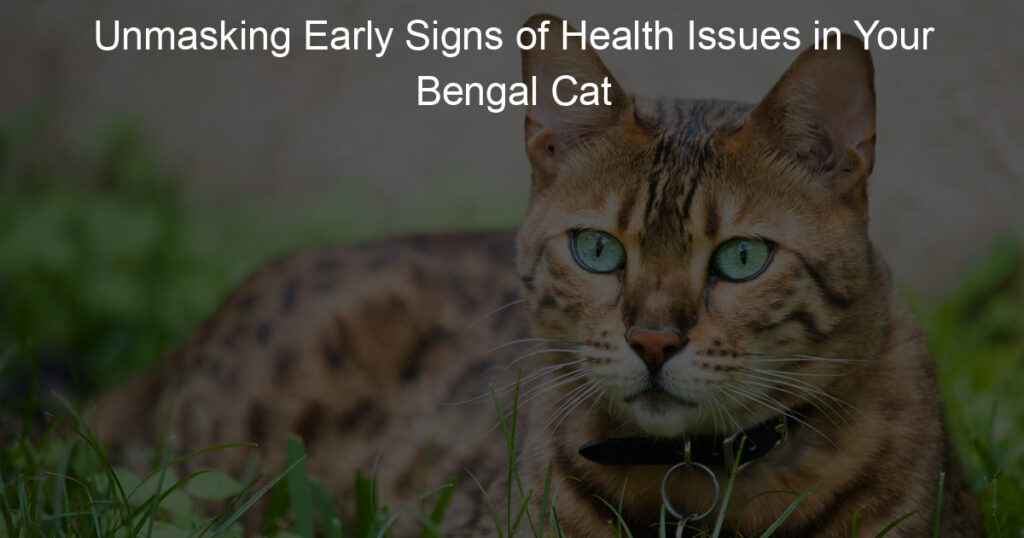
Introduction to Bengal Cat Health Concerns
When it comes to the health of your Bengal cat, it’s crucial to be aware of the potential health issues they may face. This knowledge will not only help you care for your pet better but also ensure they live a long, happy, and healthy life.
Bengal cats, like any other breed, are susceptible to certain health problems. Some of these issues are genetic, meaning they are passed down from parent cats to their kittens. Others are a result of environmental factors, such as diet, exercise, and overall care. Common health issues in Bengal cats include heart diseases, progressive retinal atrophy, and infectious diseases.
Early detection of health problems in Bengal cats is vital. It can make the difference between a minor, easily treatable condition and a severe, potentially life-threatening one. Regular vet check-ups, paying attention to changes in your cat’s behavior, and knowing the signs of common cat diseases can help catch health issues early. This early detection can lead to more effective treatments and a better prognosis for your feline friend.
As a Bengal cat owner, you have a responsibility to understand the potential health issues your pet may face. By staying informed and vigilant, you can help ensure your Bengal cat stays healthy and happy for years to come.
Common Bengal Cat Diseases
When it comes to the health of your Bengal cat, knowledge is power. Understanding the common diseases that can affect your feline friend can help you take proactive steps to ensure their well-being. Here, we’ll explore three main categories of diseases: genetic disorders, infectious diseases, and parasitic infections.
-
- Genetic Disorders
Genetic disorders are diseases that are passed down from parents to their offspring. In Bengal cats, one common genetic disorder is Progressive Retinal Atrophy (PRA). This disease affects the eyes and can lead to blindness. Another is Polycystic Kidney Disease (PKD), which causes multiple cysts to form in the kidneys, impairing their function.
-
- Infectious Diseases
Infectious diseases are caused by harmful organisms like bacteria, viruses, or fungi. Bengal cats, like all cats, can be susceptible to a variety of infectious diseases. These include Feline Immunodeficiency Virus (FIV), Feline Leukemia Virus (FeLV), and Feline Infectious Peritonitis (FIP). Regular vaccinations and good hygiene practices can help protect your cat from these diseases.
-
- Parasitic Infections
Parasitic infections occur when parasites like fleas, ticks, or worms invade a cat’s body. Common parasitic infections in Bengal cats include fleas, ticks, heartworms, and intestinal worms. Regular preventative treatments can help keep these pests at bay.
Remember, early detection is key when it comes to treating these diseases. Regular vet check-ups and being aware of any changes in your cat’s behavior or appearance can help catch these diseases early, improving the chances of successful treatment.
Next, we’ll look at some early symptoms to watch out for in your Bengal cat. Stay tuned!
Early Symptoms in Bengal Cats
Recognizing early symptoms in your Bengal cat can be the key to preventing serious health issues. Here, we will discuss some physical symptoms that might indicate your Bengal cat is not feeling well.
Physical Symptoms
Physical symptoms are often the first signs that your Bengal cat may be unwell. It’s important to keep a close eye on your cat’s physical condition, as changes can sometimes be subtle. Let’s look at some of the most common physical symptoms.
-
- Changes in Fur and Skin
One of the first signs of a health issue in Bengal cats can be changes in their fur and skin. This could include fur loss, dullness, or changes in color. Their skin might also become dry, flaky, or show signs of irritation such as redness or swelling. If you notice any of these changes, it’s a good idea to consult with your vet.
-
- Unusual Body Posture
Bengal cats are known for their graceful and agile movements. If you notice your cat adopting an unusual posture, such as hunching over or limping, it could be a sign of discomfort or pain. This could be due to a variety of issues, from joint problems to internal discomfort. Don’t ignore these signs – your cat may be trying to tell you they’re not feeling well.
-
- Loss of Appetite
A loss of appetite can be a clear sign that your Bengal cat is not feeling well. If your cat is eating less than usual, or not eating at all, it’s important to seek veterinary advice. This could be a sign of a digestive issue, dental problem, or even a more serious underlying condition.
Remember, these are just some of the physical symptoms that could indicate a health issue in your Bengal cat. Always consult with a professional if you have any concerns about your cat’s health.
Behavioral Symptoms
Behavioral changes in your Bengal cat can be an early sign of health issues. It’s crucial to observe your pet’s normal behavior so you can quickly identify any unusual changes. Here are some behavioral symptoms to watch out for:
- Changes in Activity Levels
One of the most noticeable symptoms is a significant change in your Bengal cat’s activity levels. Bengal cats are known for their high energy and playful nature. If you notice your cat becoming lethargic or less interested in play, it could be a sign of an underlying health issue. Conversely, an increase in activity, such as restlessness or hyperactivity, can also indicate a problem.
- Aggression or Fearfulness
Changes in your cat’s behavior towards you or other animals can also be a symptom. If your normally friendly Bengal cat becomes aggressive or fearful, it could be due to discomfort or pain. Remember, cats can’t tell us when they’re feeling unwell, so a change in behavior is often their way of communicating that something is wrong.
- Excessive Grooming
While grooming is a normal part of a cat’s behavior, excessive grooming can be a sign of a health issue. If your Bengal cat is grooming one area more than usual, or if grooming is causing hair loss or skin irritation, it could be a sign of a skin condition or other health problem.
These are just a few of the behavioral symptoms that could indicate a health issue in your Bengal cat. Always remember, if you notice any changes in your cat’s behavior, it’s best to consult with a veterinarian as soon as possible.
Bengal Cat Health Care
When it comes to Bengal cats, health care is an essential aspect that cannot be overlooked. Regular vet check-ups play a crucial role in maintaining your Bengal cat’s health.
Regular Vet Check-ups
Regular vet check-ups are a must for every Bengal cat. These check-ups help in early detection of diseases and ensure that your Bengal cat is in good health.
-
- Importance of Regular Vet Visits
Regular vet visits are important for several reasons. Firstly, they allow the vet to monitor your Bengal cat’s health and detect any potential health issues early. Early detection of diseases can lead to more effective treatment and a better prognosis. Secondly, regular vet visits also provide an opportunity for your cat to get necessary vaccinations and preventive treatments. Lastly, these visits allow you to discuss any concerns or questions you may have about your Bengal cat’s health with a professional.
-
- What to Expect During a Vet Check-up
During a vet check-up, the vet will typically conduct a thorough physical examination of your Bengal cat. This includes checking your cat’s weight, temperature, heart rate, and breathing rate. The vet will also examine your cat’s skin, coat, eyes, ears, teeth, and gums for any signs of illness. Additionally, the vet may also perform blood tests, urine tests, and other diagnostic tests if necessary. It’s a good idea to bring any information about your cat’s diet, behavior, and any noticeable changes to the vet’s attention.
In conclusion, regular vet check-ups are a vital part of Bengal cat health care. They not only help in early detection of diseases but also ensure that your Bengal cat is in the best possible health. So, make sure to schedule regular vet visits for your Bengal cat.
Home Care for Bengal Cats
Providing the best home care for your Bengal cat involves three key areas: proper nutrition, exercise and enrichment, and grooming and hygiene. Let’s delve into each of these aspects in detail.
-
- Proper Nutrition
Feeding your Bengal cat a balanced diet is crucial for their overall health. A diet rich in protein, vitamins, and minerals is ideal for these active cats. Avoid feeding them with human food as it may contain ingredients that are harmful to them. Instead, opt for high-quality cat food that meets their nutritional needs. Remember, a well-fed cat is a happy and healthy cat.
-
- Exercise and Enrichment
Bengal cats are known for their high energy levels. They need regular exercise and mental stimulation to keep them happy and healthy. Provide them with plenty of toys and playtime. Interactive toys that mimic prey, like feather wands or laser pointers, can keep them engaged and active. Additionally, consider setting up a cat tree or a cat-friendly outdoor enclosure for them to explore. This will not only keep them physically active but also stimulate their curious minds.
-
- Grooming and Hygiene
Regular grooming is essential to keep your Bengal cat’s coat shiny and healthy. Brush their coat at least once a week to remove loose hair and prevent matting. Bengal cats are also known for their love of water, so they may enjoy a regular bath. Additionally, regular dental check-ups, nail trims, and ear cleanings are important aspects of their hygiene routine. Remember, a clean cat is a healthy cat.
| Aspect | Key Points |
|---|---|
| Proper Nutrition | High-quality cat food, rich in protein, vitamins, and minerals |
| Exercise and Enrichment | Interactive toys, cat tree, outdoor enclosure |
| Grooming and Hygiene | Weekly brushing, regular baths, dental check-ups, nail trims, ear cleanings |
In conclusion, taking care of a Bengal cat at home involves a balanced diet, regular exercise and mental stimulation, and a consistent grooming routine. By following these guidelines, you can ensure your Bengal cat stays healthy and happy.
Spotting Health Issues in Bengal Cats: Case Studies
Understanding the health issues that Bengal cats can face is crucial for their well-being. Let’s delve into some real-life case studies that highlight the importance of early detection and proper management of these health concerns.
-
Case Study 1: Early Detection of Feline Leukemia
In this case, a Bengal cat named Bella was diagnosed with Feline Leukemia. Bella’s owner noticed that she was losing weight and had a decreased appetite. After a visit to the vet, Bella was tested for Feline Leukemia, a disease that can severely impact a cat’s immune system. The test came back positive.
Because Bella’s owner noticed these symptoms early, Bella was able to start treatment right away. With the right care and medication, Bella’s condition improved significantly. This case study shows the importance of early detection in managing serious diseases like Feline Leukemia.
-
Case Study 2: Managing Diabetes in a Bengal Cat
Our second case involves a Bengal cat named Max who was diagnosed with diabetes. Max’s owner noticed that he was drinking more water than usual and urinating frequently. After a blood test, Max was diagnosed with diabetes.
Max’s owner worked closely with the vet to manage Max’s diabetes. This involved a special diet and regular insulin injections. With proper management, Max’s diabetes is under control, and he continues to live a happy and healthy life. This case study highlights the importance of managing chronic conditions in Bengal cats.
-
Case Study 3: Overcoming Parasitic Infections
The third case involves a Bengal kitten named Luna who was suffering from a parasitic infection. Luna’s owner noticed that she was lethargic and had a dull coat. After a stool sample test, Luna was diagnosed with a parasitic infection.
With the right medication, Luna’s infection was treated successfully. Luna’s energy levels returned to normal, and her coat regained its shine. This case study emphasizes the importance of regular vet check-ups in detecting and treating parasitic infections early.
In conclusion, these case studies highlight the importance of early detection and proper management of health issues in Bengal cats. Regular vet visits and keen observation of your cat’s behavior can go a long way in ensuring their health and happiness.
Conclusion: Your Bengal Cat Health Guide
As we wrap up our comprehensive guide on Bengal cat health, it’s important to remember that keeping your feline friend healthy requires consistent effort and attention. Here are some key takeaways and resources for further reading to help you along the way.
-
- Key Takeaways for Bengal Cat Health Care
Understanding the unique health needs of your Bengal cat is crucial. Here are the main points to remember:
-
-
- Regular vet check-ups: Routine visits to the vet can help detect any health issues early.
- Proper nutrition: A balanced diet is essential for your Bengal cat’s overall health.
- Exercise: Bengal cats are active and need plenty of exercise to stay healthy.
- Observation: Keep an eye on any changes in your cat’s behavior, as it could be a sign of health issues.
- Resources for Further Reading
-
To further your knowledge on Bengal cat health, consider these resources:
-
- “Bengal Cats: A Complete Guide” – This book provides an in-depth look at the breed and its health needs.
- “The Healthy Cat Handbook” – A comprehensive guide on cat health, including disease prevention and treatment.
- “Bengal Cat Health: A Vet’s Perspective” – This article offers a professional viewpoint on common Bengal cat health issues.
In conclusion, your Bengal cat’s health should always be a priority. By staying informed and proactive, you can ensure your feline friend leads a long, happy, and healthy life. Remember, when it comes to your cat’s health, you are their best advocate.














